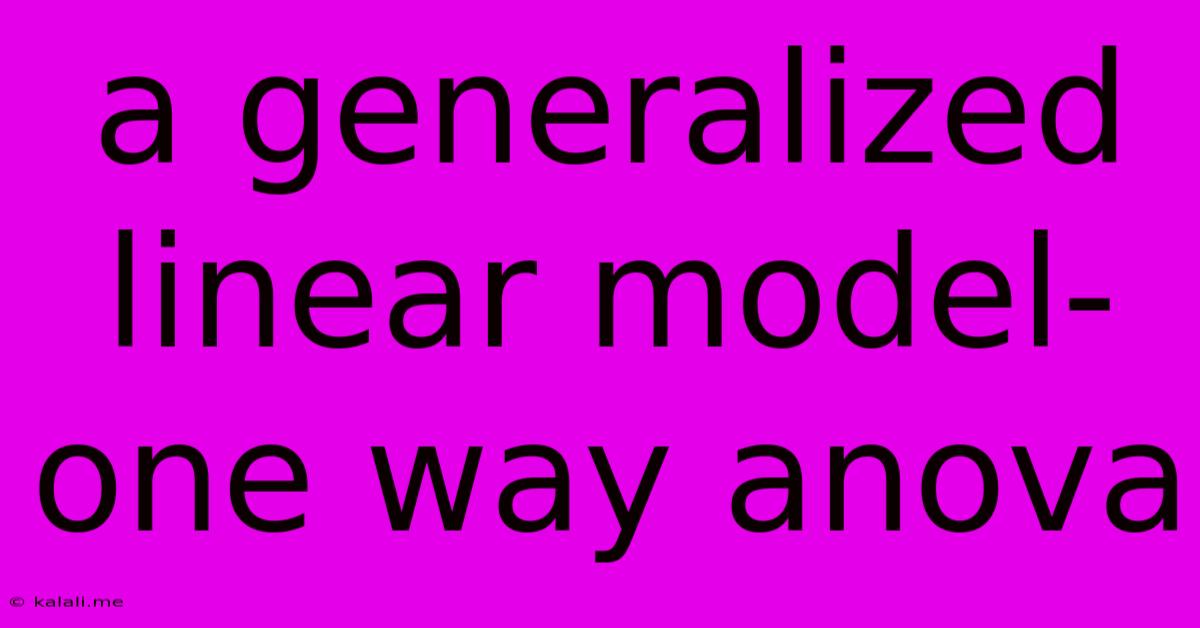A Generalized Linear Model-one Way Anova
Kalali
May 29, 2025 · 3 min read

Table of Contents
Understanding Generalized Linear Models (GLMs) and Their Application in One-Way ANOVA
Meta Description: This article explores the connection between Generalized Linear Models (GLMs) and One-Way ANOVA, explaining how GLMs provide a flexible framework encompassing ANOVA as a special case. We'll delve into the underlying assumptions, practical applications, and advantages of using GLMs for ANOVA-like analyses.
Generalized Linear Models (GLMs) represent a powerful and flexible class of statistical models that extend the capabilities of traditional linear models. While many are familiar with One-Way ANOVA for comparing means across different groups, GLMs offer a broader perspective, encompassing ANOVA as a specific instance. Understanding this relationship unlocks the potential for analyzing data with more complex structures and distributions.
What is a Generalized Linear Model (GLM)?
A GLM is an extension of ordinary least squares regression that allows for response variables following distributions other than the normal distribution. This is achieved through two key components:
-
Linear Predictor: This is the familiar linear combination of predictor variables, β₀ + β₁X₁ + β₂X₂ + ... + βₙXₙ, where β's are the coefficients and X's are the predictor variables.
-
Link Function: This function connects the linear predictor to the mean of the response variable. The choice of link function depends on the distribution of the response variable. For example, the logit link is used for binomial data (binary outcomes), the log link for Poisson data (count data), and the identity link for normally distributed data.
One-Way ANOVA as a Special Case of a GLM
One-Way ANOVA compares the means of a continuous response variable across multiple groups defined by a single categorical predictor variable (factor). This seemingly simple analysis can be elegantly framed within the GLM framework.
Specifically, One-Way ANOVA is a GLM with the following characteristics:
- Response Variable: Continuous and normally distributed.
- Predictor Variable: Categorical (the factor defining the groups).
- Link Function: Identity link (the mean of the response is directly modeled).
- Distribution: Gaussian (normal) distribution.
The GLM approach uses dummy variables to represent the categorical predictor. For example, if we have three groups (A, B, C), we could use two dummy variables: X₁ (1 if group B, 0 otherwise) and X₂ (1 if group C, 0 otherwise). Group A serves as the reference group. The model becomes:
Y = β₀ + β₁X₁ + β₂X₂ + ε
where:
- Y is the continuous response variable.
- β₀ is the mean of group A.
- β₁ is the difference between the mean of group B and group A.
- β₂ is the difference between the mean of group C and group A.
- ε is the error term (normally distributed).
Advantages of Using GLMs for ANOVA-like Analyses
While One-Way ANOVA suffices for many scenarios, GLMs offer significant advantages:
- Flexibility: GLMs handle non-normal response variables (e.g., counts, proportions). This is crucial when dealing with data that violate the normality assumption of ANOVA.
- Generalized Linear Mixed Models (GLMMs): GLMs can be extended to handle correlated data through the incorporation of random effects, resulting in GLMMs which are useful in longitudinal studies, repeated measures designs, and hierarchical data structures.
- Unified Framework: GLMs provide a unified framework for analyzing a wide range of data types, avoiding the need to learn separate procedures for different distributions.
Practical Applications
GLMs are widely used in various fields:
- Biology: Analyzing the effect of different treatments on the survival rates of organisms (binomial response).
- Ecology: Modeling species abundance in different habitats (Poisson response).
- Medicine: Investigating the association between risk factors and disease incidence (logistic regression – a specific type of GLM).
- Social Sciences: Analyzing the relationship between socioeconomic status and educational attainment (various response types depending on the data).
In conclusion, while One-Way ANOVA remains a valuable tool, understanding its relationship to GLMs expands analytical capabilities. GLMs offer a flexible and powerful framework that caters to a wider range of data types and research questions, making them a fundamental tool for data analysis across numerous disciplines. By mastering GLMs, researchers gain a more comprehensive understanding of their data and can draw more robust and reliable conclusions.
Latest Posts
Latest Posts
-
Can You Collect Money In Jail Monopoly
May 30, 2025
-
Postgres Create User If Not Exists
May 30, 2025
-
You Are The Love Of My Life In Spanish
May 30, 2025
-
Origin Of Throw Under The Bus
May 30, 2025
-
How Many Cups Is 8 Oz Of Cheese
May 30, 2025
Related Post
Thank you for visiting our website which covers about A Generalized Linear Model-one Way Anova . We hope the information provided has been useful to you. Feel free to contact us if you have any questions or need further assistance. See you next time and don't miss to bookmark.